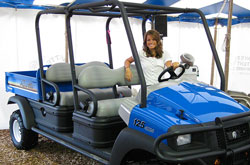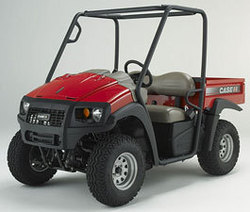Both New Holland and Case IH have decided to enter the utility vehicle market with the addition of their Rustler and Scout UTV product lines, respectively.

New Holland Ruslter 125 UTV
New Holland is targeting the rancher, farmer and property owner with their line-up of three Rustler utility vehicles:?? Models 115, 120, and 125.
New Holland offers Rustler UVs with 4×2 or 4×4 axles. For extra traction on the 14-hp 4×4 115 (gas) model, simply engage the shift-on-demand four-wheel drive, while the larger models engage four-wheel drive automatically. The 20-hp 120 (diesel) and 23-hp 125 (gas) models feature an automatic, all-wheel-drive system that delivers the gear you need, when you need it.
Lean more:?? Northwest Horse Source

Case IH Scout UTV
Case IH offers their Scout and Scout XL utility vehicles.?? The XL comes in a gas or diesel versions for 2 or 4 passengers. Key target segments for the Scout include crop and livestock farmers, contractors, and landscapers.
The two-passenger Case IH Scout offers premium features in a compact size, including: MacPherson Strut front suspension and best-in-class independent rear suspension; a wide ratio CVT transmission for fuel efficiency and smooth shifting; hydraulic, four-wheel disk brakes; ROPS protection, retractable safety belts and Halogen headlamps.
For all the comfort, safety and fuel-saving features in a bigger box, there’s the larger Case IH Scout XL. These also feature a wide ratio CVT transmission; hydraulic, four-wheel disk brakes; ROPS, retractable safety belts and headlamps; along with a double A-arm front suspension with coil overshocks for a comfortable ride; and a full-sized bed box with 800 lbs. (15.1 cu. ft.) of capacity – or 1,050 lbs. with the optional high capacity kit.
Learn more:?? PRweb.com
Comment: I believe these new product line introductions are indicative of two trends in the utility vehicle market.?? First, despite the economy and some declines in the market, the utility vehicle market is still relatively vibrant and poised for strong growth as the economy gains strength.?? In part, this is because purchasing these vehicles?? makes economic sense?? since they?? increase productivity.?? In their July quarterly analyst conference call Arctic Cat reported positive comparative UTV sales figures for 9 of 13 weeks. In contrast, both Polaris and Arctic Cat have reported significantly sharper declines for ATVs than UTVs during the economic downturn.
This leads me to the second trend in the market – utility vehicles “stealing” market share from other vehicle classes.?? One class being affected is ATVs.?? Polaris estimates a third of side-by-side vehicles are displacing ATVs.?? The other class of vehicles is tractors in the farm segment.?? I have picked this trend up in interviews with farm equipment dealers and I speculate that these new product line introductions are, in part, a response to New Holland and Case IH experiencing a negative impact on tractor sales.?? The?? other reason for the introductions is that the utility vehicle market represents a good growth opportunity, one which competitors like John Deere and Kubota have already been exploiting for a number of years. – Marc Cesare



